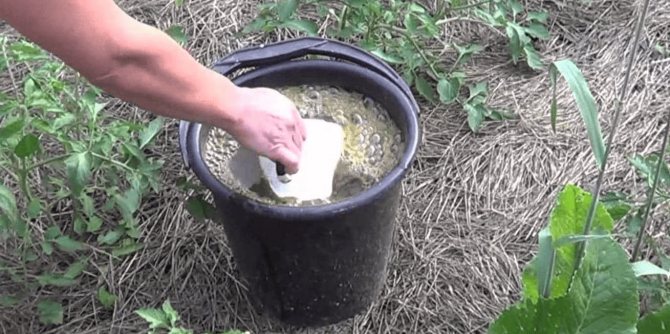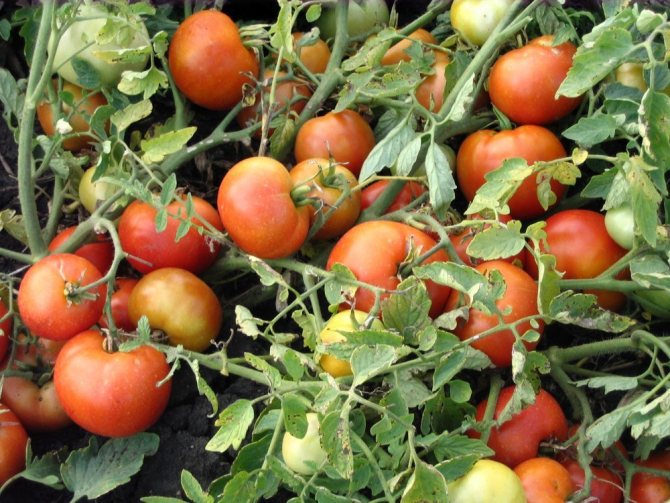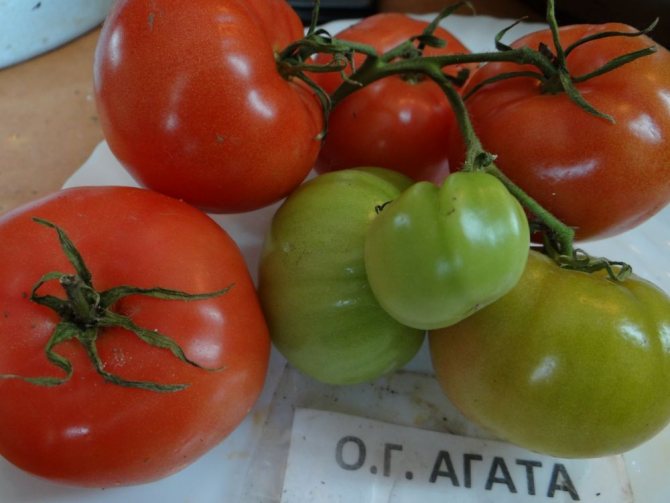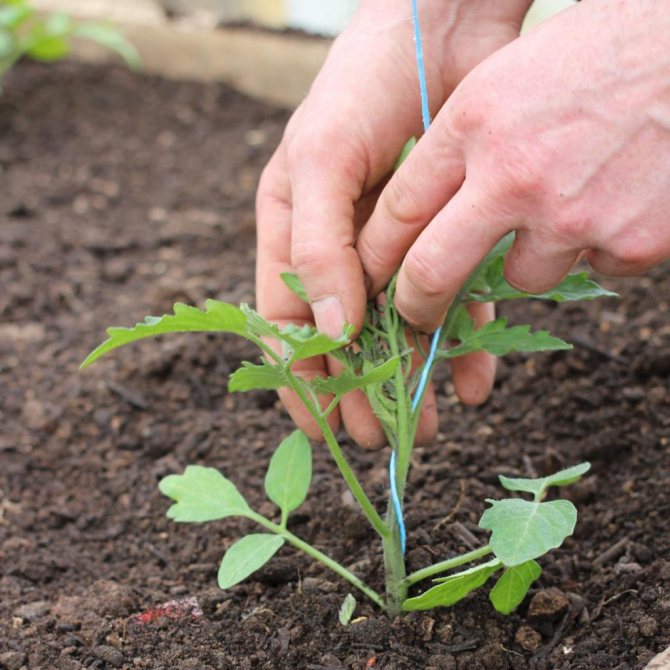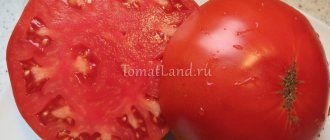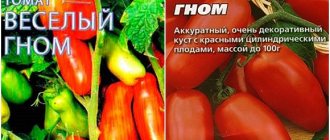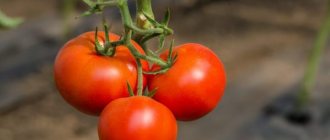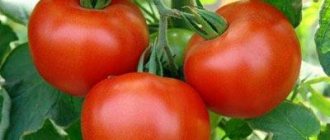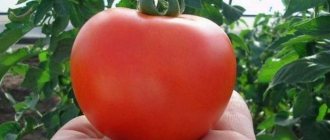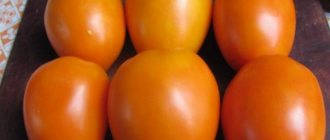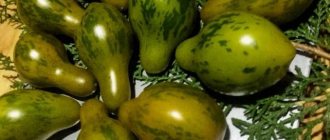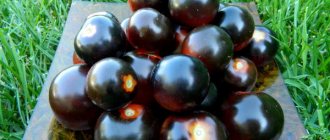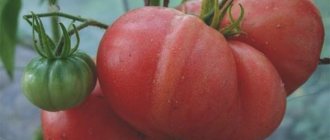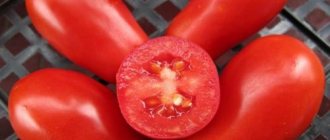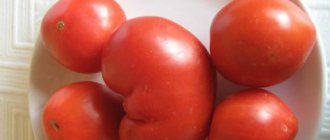»Vegetable growing» Tomatoes »Varietal features of tomato Agata
0
231
Article rating
Anyone who wants to get a high-quality and bountiful harvest of tomatoes on their site should pay attention to the Agata tomato. This early maturing variety is known for its high taste characteristics. The fruits, although not large, survive long transportation without damage.
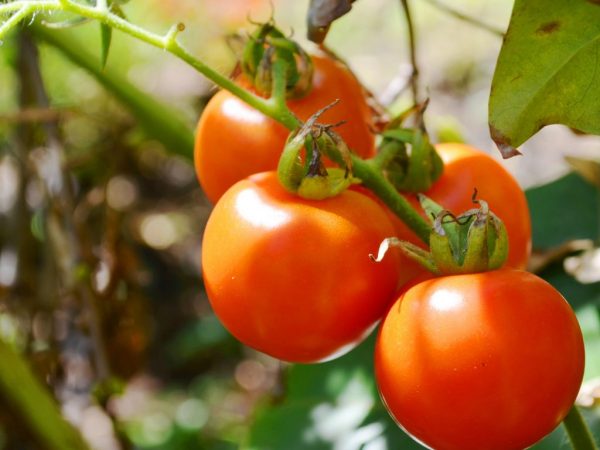
Varietal features of Agata tomato
Characteristic features of tomato agate
To navigate the variety of varieties, you need to know the characteristics of the variety, its characteristics:
- Determination, i.e. short stature (up to 45cm) is one of the main characteristics. When five brushes are formed on the bush, the growth of the plant stops. The formation of the first cluster begins after five leaves, the subsequent ones - every two leaves.
- Clusters (5-6) multi-fruited - from three to six fruits in each cluster.
- The variety is not standard, the stem under the weight of the fruit can break, lie on the ground, therefore, a garter to a support (peg) is justified. It helps to withstand strong gusts of wind, makes it possible for all parts of the plant to receive uniform lighting. The soil under the bush can be mulched or some material can be placed on the ground under the lower brushes to avoid contact with the ground (the fruits on the ground will begin to rot).
- Early ripening of fruits - 95-113 days after planting the seeds.
- Good yield - each bush yields about 4 kg of fruit.
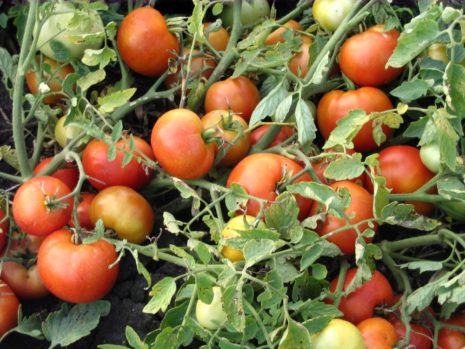

- The versatility of the variety is another main characteristic. Can be grown outdoors, in a greenhouse, in a greenhouse, both by seedlings and seeds.
- Prefers light soils.
- Immunity to diseases, especially late blight. But early ripening allows you to harvest before the spread of late blight and other diseases, to free the site from bushes for late sowing of garden crops.
- The palatability of tomato can be consumed fresh, in hot dishes, prepared in the form of juice and marinades.
Advice: in order to preserve the beneficial properties of tomato juice, it is not boiled, but heated to 70-75 °, then rolled into jars.
The variety is not capricious and demanding in care, the rules of its agricultural technology are simple and not difficult for an ordinary gardener.
Landing
First of all, you need to purchase high-quality tomato seeds, and this is not always possible. The fact is that due to the growing popularity of the variety, some unscrupulous producers and sellers pack seeds in colorful bags that do not correspond to the declared variety. Therefore, you should choose seeds from well-known, reliable manufacturers. In this regard, we can recommend the following:
- "Agrofirma Aelita"
- "Seeds of Crimea".
- Agroupech (Krasnodar).
- Lucky Seeds.
Reviews of gardeners
Irina, 41 years old, Kazan
Nikolay Ivanovich, 65 years old, Krasnodar
As you can see, the Agata tomato variety really deserves attention and the desire of gardeners to grow it is fully justified. This variety can be confidently recommended for planting not only in personal subsidiary plots, but also on farm fields for commercial use.
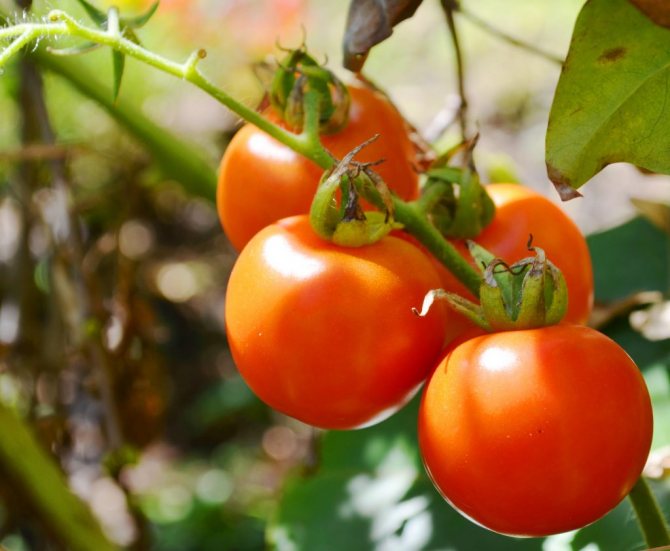

The Agata variety is popular with vegetable growers throughout Russia. Such ubiquitous love became possible because tomatoes do not require special attention and complex care procedures.Everyone who has grown this variety claims that with minimal human intervention, these plants are capable of producing an excellent harvest.
Housewives appreciate Agate tomatoes for the density and taste of their pulp. Tomatoes look great preserved in jars or as part of a vegetable salad. These tomatoes do not crack and remain intact even after some time after harvest.
This makes it possible to cultivate a variety for sale, vegetables transfer transportation over long distances without loss.
The best varieties and hybrids of tomato
Arctic
Breeders have bred many varieties of tomatoes of the most varied colors, shapes, tastes and purposes. Most varieties of tomatoes are intended for growing in a greenhouse - tasty and large fruits in the middle lane can be obtained only under special conditions, artificially extending the growing season of plants.
The earliest ripening group of tomatoes is cherry, or cherry. Even the tallest of them (indeterminate), such as Dessert, ripen at 95-100 days, and undersized sprinters (Arctic) - already at 75-80 days. Tomatoes of this group have a small mass of stems and leaves, so they can be kept in pots until fruit sets.
Due to the compactness of the bush and decorativeness, they look good both in the garden and in the pot culture. Cherry fruits contain a record amount of dry matter, in particular - sugars, can be stored for a long time even at room temperature. Plants are unpretentious, fruitful - up to 20 or more fruits are tied in the brush.
F1 Arbat
Bolshevik
The earliest ripening common tomatoes are undersized (superdeterminate). The first inflorescence is laid above 6-7 leaves, the subsequent ones are located through 1-2 leaves or directly one after the other. Upstart, F1 Citizen, F1 Paradise begin to bear fruit 95-105 days from the moment of germination. These varieties are distinguished by amicable filling of fruits and can be grown both in a greenhouse and in the open field.
Following them, medium-sized (determinant) F1 Arbat, F1 Rover, F1 Shustrik and F1 Kulinar enter fruiting. In these tomatoes, the formation of inflorescences begins above the 7-9 leaves. Large-fruited, weighing up to 200 g, F1 hybrids Big Brother, F1 Bolshevik, F1 Piglet and variety Pink cheeks also begin to ripen 5-10 days later than undersized ones.
F1 Sharp
Zhuravlik, Pagoda, F1 Red Manul, F1 Svoyak, F1 Khan, F1 Die Hard will help to extend the terms of consumption. They begin to bear fruit at 110-115 days from the moment of germination. The high productivity of these hybrids is combined with the suitability of the fruit for storage. Even later, F1 Katyusha ripens with large, dense fruits of bright red color.
In indeterminate (tall) tomatoes, the first inflorescence is laid quite high (after 9-11 leaves), the subsequent ones are located after three leaves. This group includes the most late-ripening varieties and hybrids, which are grown in heated glazed and film greenhouses in the middle lane. F1 Sharp, F1 Erema, F1 Commissar, F1 Lyubava, F1 Master, F1 Manechka, F1 Navigator and F1 Flute are distinguished by high yield, long-term fruiting, since plants are not limited in growth, as well as resistance to most greenhouse diseases.
ARCTIC
Unpretentious superdeterminant super-early variety: before ripening 75-80 days. Plants are undersized, up to 40 cm high. Fruits are round, small (up to 15 g), raspberry-pink when ripe. It is possible to grow in the open field, in a pot culture for landscaping balconies and loggias. Planting density 6-8 plants / sq.m.
Upstart
F1 Citizen
F1 Paradise
UPSTART
Early ripening variety: from germination to ripening 95-105 days.Plants 70-100 cm high (depending on the place of cultivation and the method of formation). Fruits weighing 80-110 g, smooth or slightly ribbed, rounded, red when ripe. Recommended for growing in open ground and film shelters. Planting density 3.5 plants / sq. M. Advantages of the variety: amicable, almost simultaneous filling and ripening of fruits on the first 3-4 inflorescences and, as a consequence, a high early harvest.
F1 CITIZEN
Decorative cocktail tomato, combining early maturity, yield, high taste of fruits weighing up to 30 g. Ideal for growing on balconies and windowsills in a pot culture. For early ripening of fruits, it is necessary to pinch the lateral shoots (stepchildren).
F1 PARADISE
Early ripening, from germination to ripening of the first fruit 95-100 days. Plants up to 1.5 m high. Fruits weighing 100-120 g, rounded, slightly elongated with a green spot at the point of attachment of the peduncle. Advantages of the hybrid: high early and general yield. Wide ecological plasticity - suitable for use in greenhouses, shelters and open ground.
F1 ARBAT
Early maturing, from germination to the first harvest 100-105 days. Plants 70-100 cm high. Fruits are cylindrical, weighing 90-100 g, dense, red when ripe, suitable for canning. Designed for growing in open ground, film greenhouses and shelters. Planting density 3-3.5 plants / sq. M. Resistant to tobacco mosaic virus, cladosporium, fusarium.
F1 Rover
F1 Cooking
F1 Big Brother
F1 ROVER
Early maturing; from germination to ripening 100-110 days. Plants 80-100 cm high. Fruits are medium, ovoid, weighing 90-100 g, red when ripe, suitable for canning. Recommended for growing in open ground, film greenhouses and shelters. Planting density 3-3.5 plants / sq. M. Resistant to tobacco mosaic virus, cladosporium, fusarium.
F1 COOKING
Early maturing, before the first harvest 105-110 days. Plants 80-100 cm high. Fruits are medium, ovoid, dense, weighing 100-110 g, red. Designed for growing in open ground, film greenhouses and shelters. Planting density 3-3.5 plants / sq. M. Suitable for canning. Resistant to tobacco mosaic virus, cladosporiosis, fusarium.
F1 BOLSHEVIK
Early maturing; from germination to ripening 105-110 days. Plants with a height of 70-80 cm (when formed in a greenhouse, the height of plants is up to 1.5 m). Fruits are large, weighing 180-200 g, multi-chambered, with dense pulp, red when ripe. Designed for growing in open ground, film greenhouses and shelters. Planting density 3-3.5 plants / sq. M. Resistant to tobacco mosaic virus, cladosporiosis, fusarium.
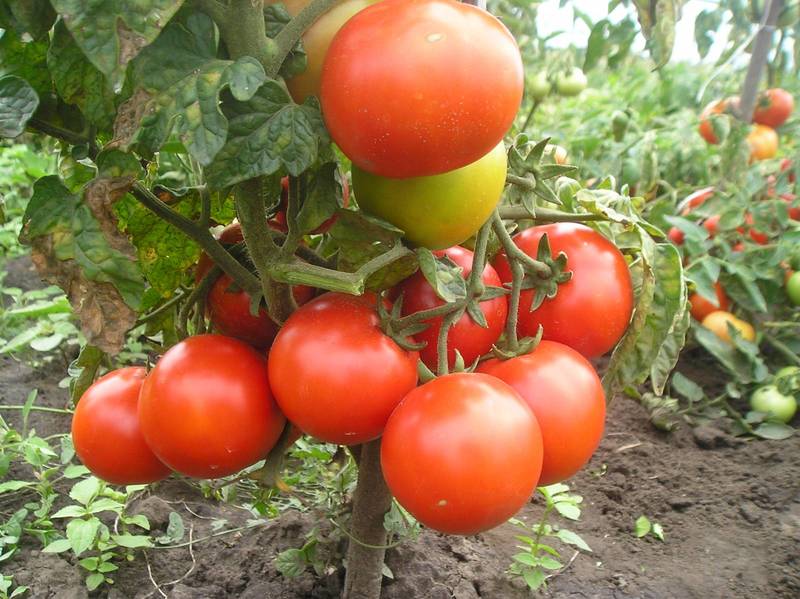

F1 BIG BROTHER
F1 Piglet
Pink cheeks
Crane
F1 HEAD
Early ripe: from germination to the first harvest 105-110 days. Plants 80 cm high. Fruits are large, weighing up to 120 g, flat-rounded with dense pulp, red when ripe, used for fresh consumption. Recommended for growing in open ground and film shelters.
PINK CHEEKS
An early ripening variety, from full shoots to ripening 108-115 days (depending on the method and place of cultivation). Plants with a height of 0.6-0.8 m to 1.5 m (when formed in a greenhouse, when the growth point is transferred to a lateral shoot, i.e. plant growth is artificially extended). Fruits are large, weighing 200-350 g, multi-chambered, with dense pulp.
The color of unripe fruits is green, with a dark green spot at the place of attachment of the peduncle; when ripe, the fruits acquire a beautiful raspberry-pink color. The variety is intended for growing in open ground and in film greenhouses and shelters. Planting density 3-3.5 plants / sq. M. Advantages of the variety: a combination of early maturity and large-fruited, raspberry-pink fruit color, high taste.
Crane
Medium early variety: from germination to ripening 110-115 days. Plants 80-100 cm high. Fruits are 2-4-chambered, smooth and slightly ribbed, weighing 90-120 g, rounded-ovate, sometimes round, light green without a spot at the place of attachment of the peduncle, dense, red when ripe, suitable for whole-fruited canning Designed for growing in film greenhouses and shelters;
F1 Die Hard
Pagoda
F1 Red Manul
F1 STRONG NUT
Early ripe: from germination to the first harvest 105-110 days. Plants 150-180 cm high. Fruits are round, with a smooth surface, medium and large, dense, intensely red when ripe. Recommended for growing in greenhouses in the middle lane, to the south - in the open field.
PAGODA
Medium early variety: from germination to ripening 105-110 days. The plants are vigorous (up to 2 meters). Fruits are 4-chambered, smooth, dense, weighing about 100 g, round in shape with a weak spot at the place of attachment of the peduncle, intense red when ripe. The variety is intended for cultivation in a greenhouse and in the open field (using the recommended forming).
F1 RED MANUL
Medium early: from germination to the first harvest 110-115 days. Plants 60-80 cm high. Fruits are flat-rounded, weighing 150-180 g, dense, red when ripe; used for fresh consumption. The hybrid is recommended for indoor and outdoor cultivation. Resistant to tobacco mosaic virus, cladosporiosis, fusarium.
F1 Brother-in-law
F1 Khan
F1 FRIEND
Mid-early: from germination to the first harvest 110-115 days. Plants 70-90 cm high. Fruits are flat-round, weighing 140-150 g, dense, red when ripe, used for fresh consumption. Recommended for indoor and outdoor cultivation. Resistant to tobacco mosaic virus, cladosporiosis, fusarium.
Growing methods and care
Seed planting
Planting with seeds in the ground or greenhouse is possible in areas with a warm climate, where temperatures are above zero early at night. Planting technology is the same as when planting seeds for seedlings. After planting the seeds, the bed should be covered with a foil until shoots appear. Further, depending on the temperature, the film can be removed during the day or put arcs for the film covering.
The key to a good harvest is healthy and strong seedlings. When growing it, you should know some points associated with this variety, and the sequence of work:
- When buying seeds, be sure to pay attention to the expiration dates.
- Buy zoned varieties.
- The seeds should be disinfected by placing them in potassium permanganate (a slightly pink solution) for 20 minutes, remove the floating ones (they are not suitable for planting), rinse the remaining seeds under running water, dry them.
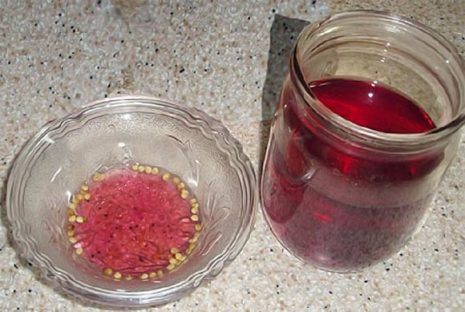

- Soil for seedlings can be bought ready-made, already enriched with nutrients, or you can prepare it yourself: peat (7 parts), sod land (1 part), sawdust (0.5 parts) or humus (30%), peat (60%), river sand (10%). It is advisable to prepare the soil in autumn, freeze it in winter (disinfection method).
- The sowing date depends on the date the seedlings were planted. Usually it takes from 45 to 80 days from the moment of planting to the moment of disembarkation in open ground, from 30 to 35 - when disembarking in a greenhouse.
- Seeds should be deepened into the ground (grooves, holes) by no more than 2 3 cm, planted in moist soil.
- The temperature regime before the dive is 20 ° -25 ° (on cloudy days - up to 20 °).
- Dive with two constant leaves. Daytime temperature - 25 ° -27 °, at night - 14 ° -17 °.
- Replenish the lack of lighting by installing fluorescent lamps.
- Drizzle with water at room temperature.
- Two weeks before planting, start hardening the seedlings: water less often, accustom to the sun's rays, fertilize (fertilizer with potassium), process with Bordeaux mixture (1%). A week before planting, place the seedlings in a cooler place (you can open the windows), but do not create a draft.
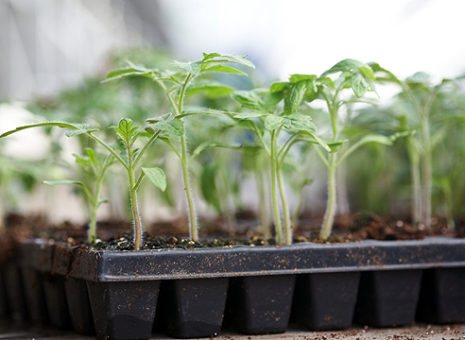

Landing
Before sowing, the seeds are immersed in a solution of potassium permanganate, then washed with clean water and soaked for a day. They are planted to a depth of 5 mm. Shoots can be expected for 5-6 days. The optimum temperature for seed germination is 18-25 degrees.
After the formation of 1-2 true leaves, the seedlings are seated. Further care of the seedlings consists in watering, loosening and hardening. It is necessary to open the seedlings after they have taken root. They should be fed once with superphosphate to strengthen the root system.
For hardening, containers or pots are taken outside for 2-3 hours, gradually increasing the time. Hardened seedlings take root faster, looks strong, stocky, and suffers less from the difference in day and night temperatures.
Seedlings are planted in the ground when the threat of frost has passed. There should be one flowering brush on the seedlings. The plants are about 60 days old by this time.
The bushes are planted at a distance of 30-35 cm from each other. A glass of humus is introduced into the hole during planting. After the plant, it is watered abundantly, and during cultivation, it is fed 2-3 times with a complete fertilizer, including nitrogen, phosphorus and potassium.
During the season, the plants need to be watered several times infrequently, but abundantly. Frequent watering impairs the taste of the fruit and reduces the sugar content. Many varieties of tomatoes crack with rare abundant watering, but Agatha is resistant to this phenomenon.
Unfortunately, growing tomatoes in a seedless way is possible only in the southern regions of the country. For the northern and middle latitudes, including in the Moscow region, the need to grow tomatoes by the seedling method is due to the short and often cold summer. Correct agricultural technology is the key to success and a good harvest of tomatoes.
Sowing seeds
The timing of sowing seeds for seedlings varies depending on the region. For Agatha, as for all early varieties of tomatoes, planting in the ground at the age of 45-50 days is relevant. That is, sowing should be carried out about a month and a half before the planned planting.
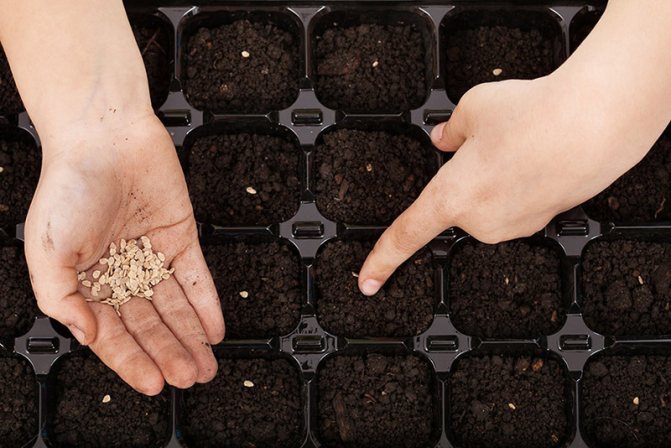

Sowing tomato seeds for seedlings
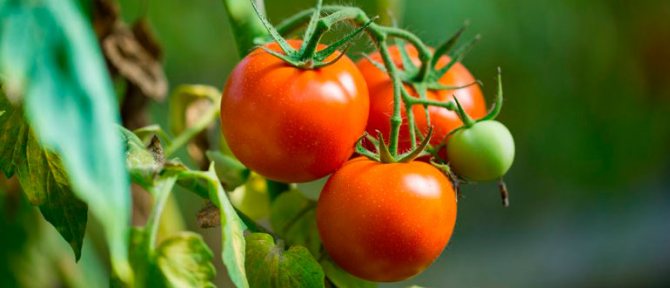

To exclude sowing of non-germinating seeds, use a saline solution. When immersed in it, the pacifiers immediately float up, it makes no sense to plant them. After that, tomato seeds are treated with disinfecting solutions. Among the best treatments, Fitosporin M can be distinguished, which prevents the appearance of pathogenic fungi. Also at home you can use potassium permanganate for this.
Some gardeners recommend germinating seeds before sowing and planting the seeds immediately in separate containers. But this is not at all necessary, since further picking of tomatoes has a beneficial effect on their development, they can be sown into the soil immediately after processing.
Sowing soil is purchased in a store or harvested in the fall. If the soil is taken of its own production, it must first be disinfected by frying it in the oven.
Sowing seeds is carried out to a depth of 1.5 - 2 cm, slightly tamping the soil surface. If the sowing is done deeper, the seeds can germinate for a long time and unevenly. With shallower sowing, the young leaves may not have enough strength to shed the seed coats. This will delay development or even kill seedlings.
Young plants begin to dive into separate pots with the appearance of two true leaves on them.
Landing in the ground
Approximately 2-3 weeks before planting in the ground, tomatoes are subjected to a hardening process. To do this, they are taken out to the loggia or glazed balcony at first for 1-2 hours a day. Every day the time of the "walk" increases. And a few days before the planned disembarkation, the seedling pots are no longer brought into the house at night.
By the time of planting, the plants should be well adapted to the harsher outdoor or greenhouse conditions. Seedlings should have dark green saturated color of leaves and plump, plump stems.
Agata tomatoes are planted in greenhouses from mid-May.Landing in open ground in central Russia is carried out no earlier than May 25. To protect young plants from possible return frosts, you need to take care of temporary shelter.
On a pre-prepared bed for each plant, a hole is prepared sufficient for free placement of the tomato root system along with an earthen lump. Fertilizer for tomatoes is placed in the hole, and a plant is planted. The ground around the tomato is compacted and watered abundantly.
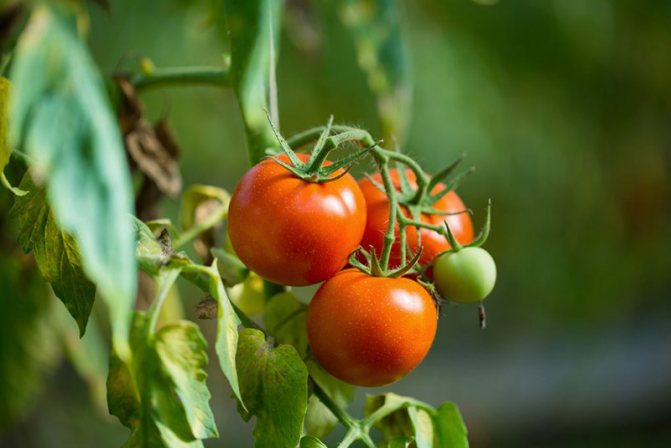

Low-growing Agata tomatoes do not require much space; up to four plants are freely placed on one square meter. The standard scheme for planting seedlings in a greenhouse is 50 * 50 cm.
One of the advantages of the variety is its undemanding care. Mandatory events include:
- regular watering with warm, settled water;
- triple feeding with complex fertilizers;
- soil mulching;
- organization of low pegs for tying.
The variety is not required and even contraindicated, since each subsequent peduncle is formed on a new stepson. But the lower tier of leaves is simply necessary to cut off in order to provide sun access to the soil and ventilation. This simple procedure will avoid most fungal diseases.
After each watering, the soil under the tomato is loosened and mulched, this allows you to keep the soil moist, while preventing the development of fungi and mold. Preventive spraying with Bordeaux liquid will help avoid possible outbreaks of late blight.
The weak resistance of the Agata variety to diseases can scare off even experienced gardeners. But we must remember that all plants, without exception, are susceptible to diseases. And, in order to get good harvests, it always takes a little effort.
The best varieties of low-growing tomatoes with photos and descriptions
Low-growing tomatoes are in the lead in summer cottages and vegetable gardens. What is the reason for this success? Why did tall vines with large fruits give way to their inconspicuous relatives?
- Low-growing tomato varieties do not require planting equipment, a lot of attention and are distinguished by high yields.
- Most undersized varieties do not need to be pinned, they grow with a stem.
- They quickly bear fruit and delight with a rich harvest.
- They differ in friendly fruiting, which is important for housewives.
- Tomatoes of this type manage to give up the main part of the crop before the onset of the active phase of late blight.
Each gardener chooses the best varieties of low-growing tomatoes for himself individually, depending on the region of residence and growing conditions.
In order to choose the right tomatoes for your site, you need to know that all low-growing tomato varieties belong to the determinant group, which is divided into three subgroups:
- determinant;
- semi-determinant;
- superdeterminant.
- The determinant subgroup of tomatoes is intended for planting in open ground and indoors. The side shoots of the bushes are very densely located, due to which a stem is formed, which does not require tying and pinching.
- Semi-determinant tomato varieties are recommended for outdoor cultivation. If you do not pinch off the top at a height of 80-90 cm, then it can reach 120 cm. Tomatoes of this group are not recommended to be pinched to harvest a larger crop, but experienced gardeners resort to this technique to speed up the fruiting of the bush.
- Superdeterminate tomatoes are characterized by early and medium ripeness, amicable fruit return, good productivity. These varieties are characterized by a short growing season. After the amicable return of the fruits, they do not form a new ovary. All varieties of tomatoes of the superdeterminant group require pinching and forming a growth point.
It is better to buy hybrid seeds of low-growing varieties of tomatoes for greenhouses and open ground of all three subgroups in specialized stores, since those collected with their own hands lose their maternal properties, and instead of a small bush, a long liana can grow in the garden.
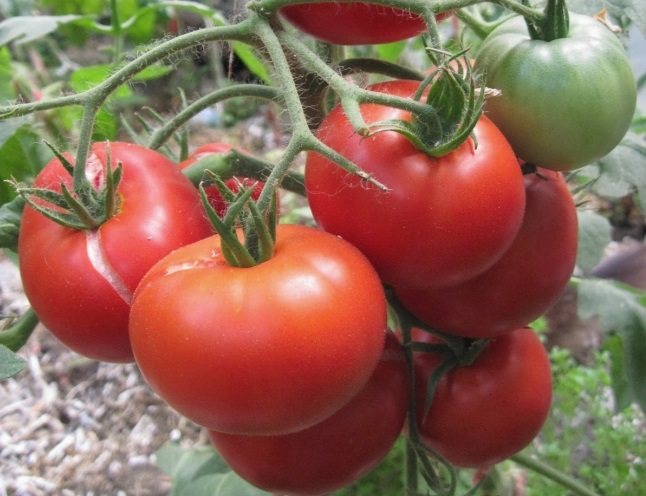

Everyone is used to the fact that tall varieties of tomatoes grow on a long trellis in the greenhouse. But there is not always the time and opportunity to engage in the formation of a bush, the distribution of brushes, and pinching. Then low-growing varieties of tomatoes come to the rescue, which are simple and easy to care for.
Among the wide variety of tomatoes, I would like to highlight some of the best varieties of low-growing tomatoes for greenhouses:
- "Magus H" is a hybrid of early fruiting, it is distinguished by its resistance to diseases and productivity. The growing season is up to 65 days, the fruits are red, round, weighing up to 180g. One meter can accommodate 3-4 plants, which is very important when growing indoors, as thickened plantings increase the yield several times. The main condition for planting this variety is frequent airing of the greenhouse and the absence of condensation.
- The novelty of the last season "Orange Princess" has proven itself well in greenhouse conditions. It is a low-growing, very high-yielding variety of medium late ripening, intended for cultivation in greenhouses and greenhouses. With good care and agricultural technology, up to 40 kg of sweet orange fruits can be obtained from one bush per season.
- Recently, cherry tomatoes have become more and more popular. From this group it is worth highlighting such undersized varieties as "Aztec", "Little Red Riding Hood", "Duckling", "Banana Legs". The fruit weight of these tomatoes does not exceed 15–20 g, and the sweet aromatic taste does not leave anyone indifferent. Small peas in marinades look especially beautiful as a decoration for salads and baked meat dishes.
- Among low-growing tomatoes, there are popular dwarf and ampelous varieties. Tomatoes variety "Talisman" feel great in baskets and hanging pots. They serve as an excellent decoration for winter gardens and greenhouses, look beautiful in the garden, suspended from tree branches.
- The Aztec variety is ideal for indoor and balcony cultivation. Plants of these tomatoes are often planted in tubs and flower pots. Then tomato bushes play the role of decoration, not just food. Dwarf tomatoes and cherry varieties have medicinal properties: their regular consumption reduces the risk of cancer.
All varieties of low-growing tomatoes are suitable for open ground. The huge variety of tomatoes in this group allows you to choose tomatoes of any color, taste and size.
- Many people like undersized tomatoes for open ground of Siberian selection: "Siberian Garden", "Sibiriada", "Heavyweight of Siberia", "Abakan Pink", "Ballerina", "Siberian Troika", "Moscow Grushovka". The varieties of this series are distinguished by high yields and resistance to viral diseases.
- Novice gardeners should pay attention to such open field tomatoes as "Alaska", "Parodist", "Boni-M", "Bobkat". They are distinguished by smooth and tasty fruits, form a lush bush on their own and do not require pinching.
- Fans of especially fruitful varieties will like the following varieties: "Rocker", "Tourmaline", "Russian tasty", "Sunny Bunny", "Buyan". With proper care, up to 5 kg of even fruits weighing from 150-200 g can be removed from one bush of tomatoes of these varieties.
- The ultra-early hybrid tomatoes "Bringing good luck" and "Gayas Bekseev" deserve special praise. They are distinguished not only by high yields, but also resistance to heat and dry soil, diseases, and are recommended for growing in areas unsuitable for gardening and agriculture.
A large assortment of low-growing tomatoes is presented today not only in specialized stores, but also in the markets of the country, where it is not always possible to be sure of the quality of products and compliance with the variety. It is better to play it safe and buy seeds in a store where experienced specialists will share the secrets of successfully growing undersized tomatoes in greenhouses and in the garden.
Yield
Some argue that from one square meter of a vegetable garden can be collected from six to seven kilograms of fruit. Although other sources call much smaller parameters - from two to four kilograms. It depends on the growing conditions and care.
When grown on large areas industrially, the yield is from 580 to 670 centners per hectare, which confirms the above figures.
To achieve a good harvest, it is necessary to study the rules of growing, planting tomatoes and strictly adhere to them. If you provide proper care, 3-4 kg of tomatoes can be harvested from one bush.
If you want to grow tomatoes from seed, plant them in early April. To improve germination and prevent various diseases, before planting, the seeds are treated with a manganese solution, and then washed under running water. This option is suitable for southern regions, where the ground warms up earlier and there are no night frosts.
When growing seedlings, you need to correctly distribute the bushes. For 1 sq. m should not contain more than 4 plants. The scheme for planting Agata tomatoes in the garden is 50 cm by 50 cm. Seedlings are planted in the ground at the end of May. You can do this earlier, in mid-April, but in this case you need to cover the beds with foil.
The Agata tomato variety is notable for its weak resistance to diseases, but early ripening of the fruits saves it. Agate allows you to fully harvest before the epidemic of late blight and other diseases of plants from this family begins.
For growing this variety, the beds on which they grew earlier are well suited:
- onion;
- peas;
- carrot;
- beans;
- cucumbers.
Plants need to be watered regularly with warm water. In addition, they need pinning. If necessary, you can remove all the lower sheets to the very ovary. In order for the tomatoes to ripen evenly and not in contact with the ground, each bush must be tied up.
In the future, you have to fight weeds, loosening the soil in the beds, feeding and watering plants. For the prevention of diseases and the fight against insects, plants are sprayed with infusion of onions, garlic or soapy water.
Top dressing
The Agata tomato variety will delight you with a rich harvest if you add top dressing on time. The first time it should be carried out 2 weeks after disembarkation. To do this, you need to dilute in 10 liters of water:
- 2 tbsp ammonium nitrate;
- 7 tbsp superphosphate;
- 5 tbsp potassium salt.
The second feeding will be needed during the fruiting period. For her, nitrogen fertilizers are not used. During the growing season, fertilizers such as:
- garden compost;
- ash;
- infusions of weeds.
High-yielding variety. From a bush, you can get up to 4 kg of fruit, from a hectare - an average of 600 centners. Tomatoes ripen together. In the first week of fruiting, plants give almost half of the harvest.
Disease prevention and control
Late blight (fungus), and not only it, affects many garden crops. The appearance of black spots on the leaves and fruits indicates a late blight infection.
You may be interested in:
Preventive measures consist of treating plants with chemicals (available in specialized stores). You can prepare 1% Bordeaux liquid (copper sulfate - 100g, slaked lime - 100-150g per ten liters of water) and treat the plants with it 14 days after planting.
Such preventive treatment helps to cope not only with late blight, but also with other diseases of tomatoes.
The sweetest and best varieties of tomatoes for greenhouses
Those gardeners who prefer not to buy tomatoes on the market, but to grow them on their own in a greenhouse, of course, are interested in the question - what varieties of tomatoes for greenhouses are best to choose? After all, you want your vegetables to be not only beautiful, but also juicy and tasty. Experts have divided all types of tomatoes into determinate and indeterminate, depending on growth and some other parameters. It is among them that we will help you choose the best ones.
Advantages and disadvantages of the variety
Each variety has its own advantages over other varieties, which should be considered when selecting seeds for planting on the site.
Agata tomato has advantages:
- early maturation;
- dense skin does not crack, ensuring safety during transportation;
- decent harvest;
- different applications: fresh, in blanks (juice, paste, marinades, dried);
- the possibility of growing seedlings and seeds;
- growing in open ground and in greenhouses (hotbeds);
- cultivated for 30 years (this is a long time).
The disadvantages of the variety include susceptibility to late blight disease. But modern methods of protection and early ripening (before the spread of late blight) allow you to enjoy a good harvest.
Using
Tomato "agata" is a variety of universal use. It is suitable for fresh use, for making salads. Tomatoes can be canned, because they are small and fit perfectly into the neck of the jar. It is useful to prepare tomato juice for the winter by grinding the agate tomato. Reviews say that if you do not boil it, but bring it to a temperature of 70 degrees and close it with a metal lid, then in winter you can feel the taste of a fresh tomato, and all the vitamins in the juice will be preserved.
Tomato paste is also prepared. But for this, tomato juice is subjected to prolonged exposure to temperature, because vitamins are unlikely to be stored there.
The description of the Agata tomato variety indicates its universal application. Delicious, sweet tomatoes are consumed fresh, used for making salads and preservation. Small fruits easily pass into the neck of the jar. If you grind them, you get tomato juice, which stands in a cool place for months.
The Agata tomato variety is kept fresh for quite a long time, which explains the demand for the vegetable among farmers and heads of agricultural enterprises that grow tomatoes for the purpose of sale.


